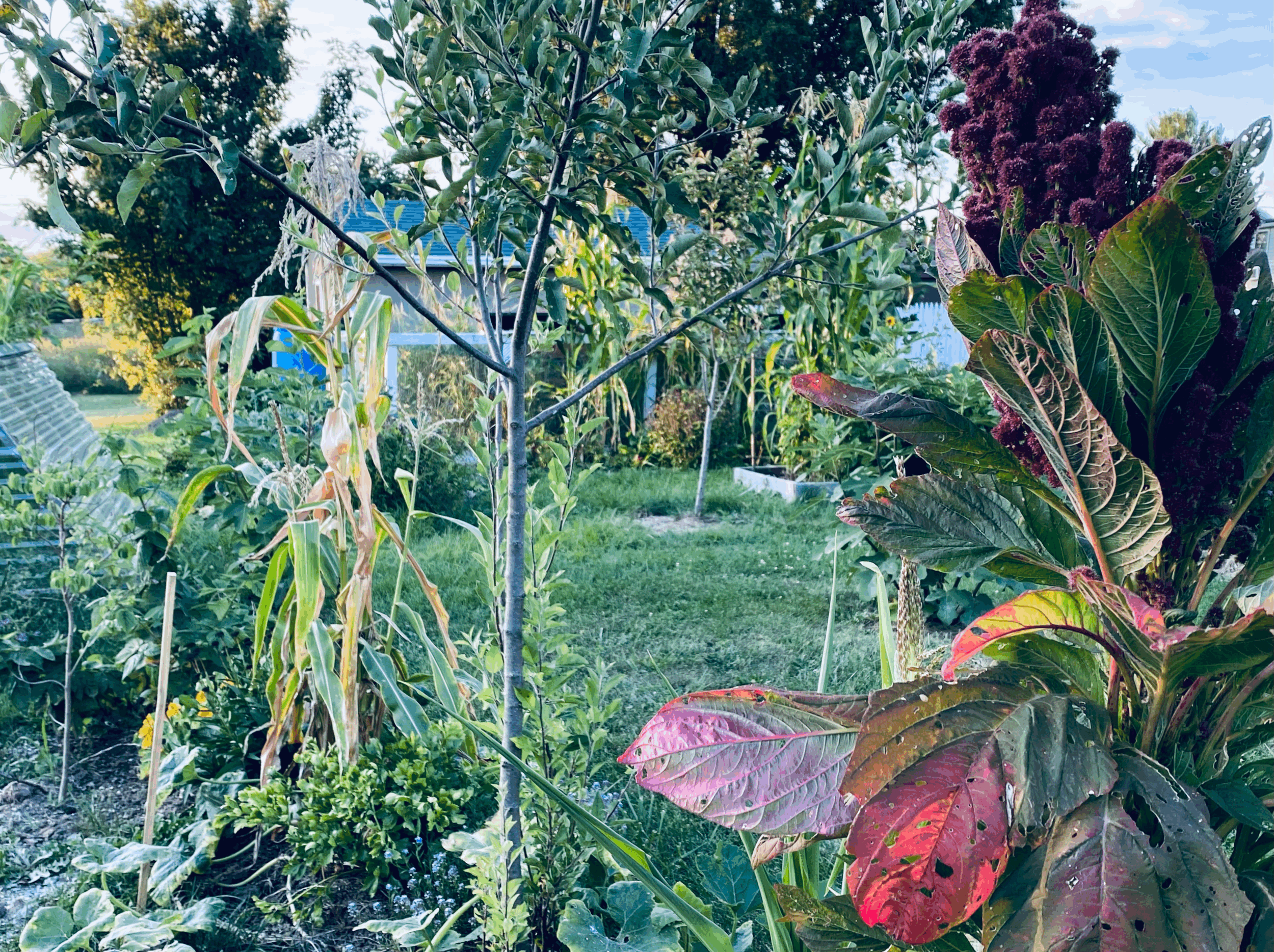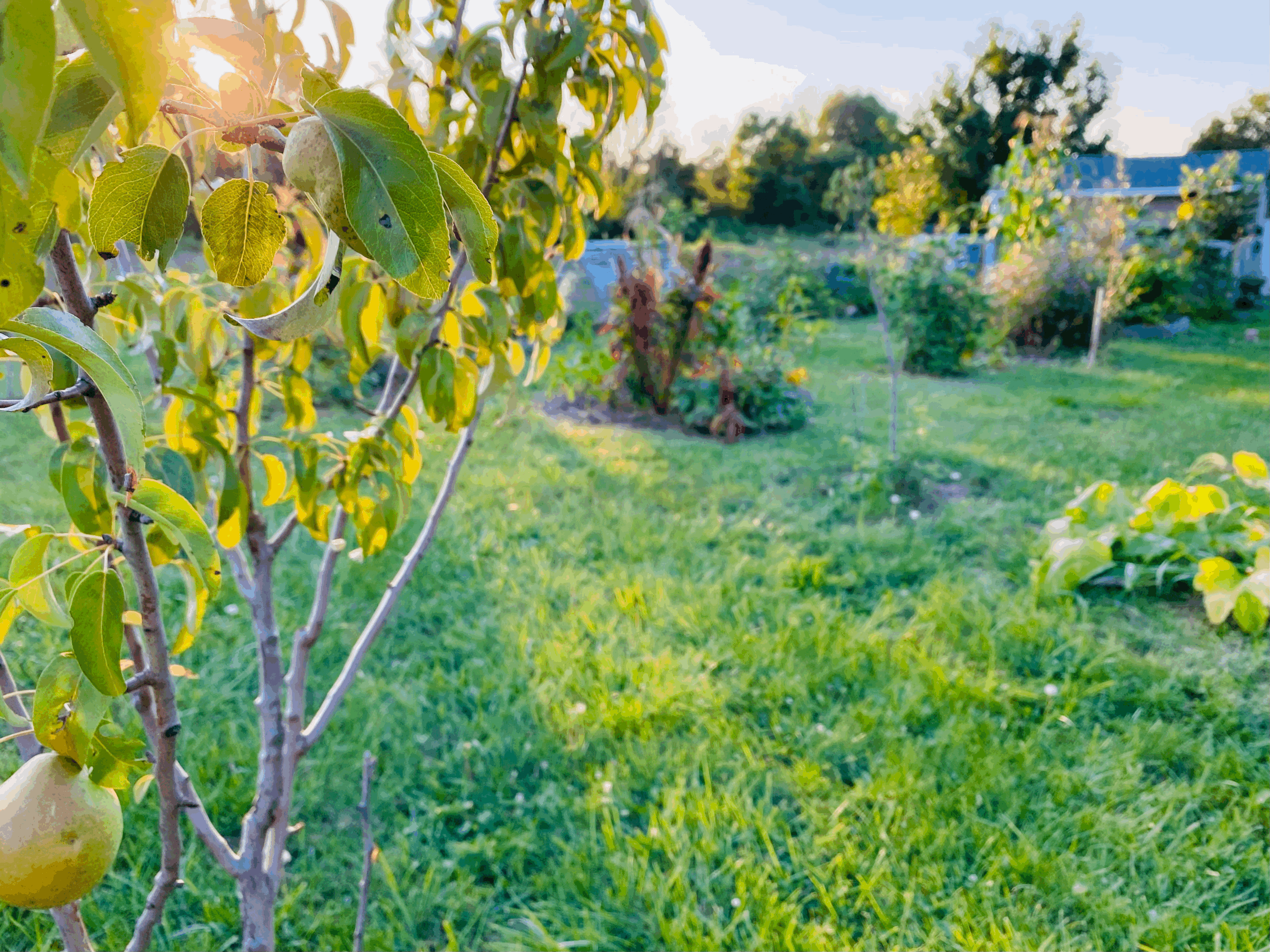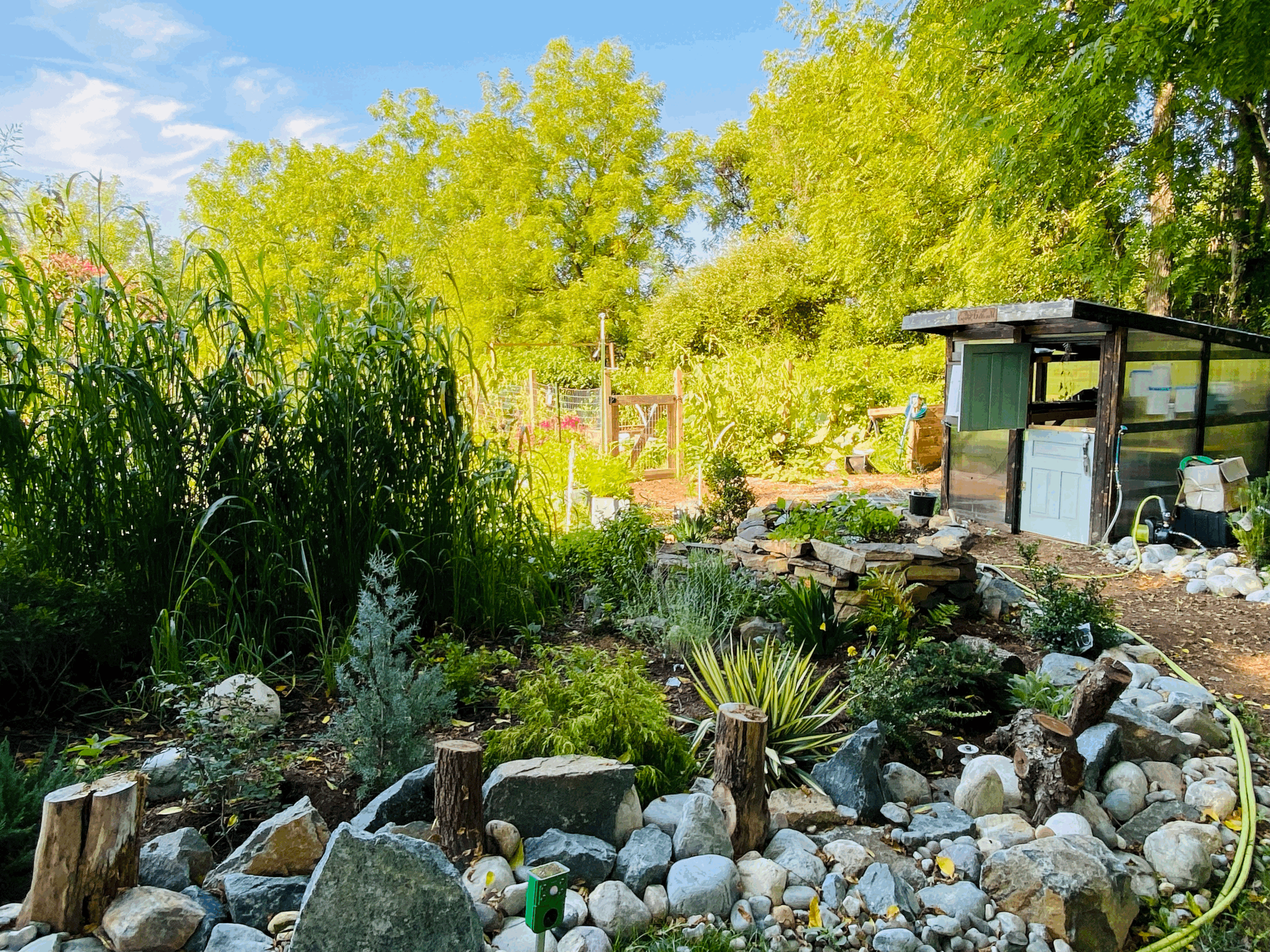Autumn in the Forest Garden
In our last post, we covered the basics of what a food forest or a forest garden consists of. I would love to tell you there is no work involved in permaculture, and while the many benefits do include systems that immensely lighten the workload, there are certainly monthly and seasonal chores to tend to. Our goal is to have closed loop systems that require very little input from us. To maintain harmony as well as continue to build healthy soils, there are some monthly chores on the permaculture homestead. These tasks are often enjoyable and will vary somewhat depending on which zone you are in. Here in zone 7a permaculture guides us with a whole list of worthy tasks for the beginning of autumn/end of summer. Harvesting, seed saving, and seasonal maintenance of our soil such as adding compost to top beds for new plants, chop and drop mulching in place, or seeding a cover crop are all important fall tasks.
Canning, drying, freezing, and preserving our yields for their many uses is imperative at this time of year. Those tomatoes have all provided a bit much. The spicy peppers are in vast supply. The lavender is out of control, ready for your use, and needs plucked back to the woody branches. The squash is innumerable, and we can’t think of anymore recipes. The Borage, with its beautiful star patterned flowers, has fallen all over itself. The Comfrey plants have become gigantic bushes. Hasten your steps now, there are medicines to be made.
I wanted to mention something worth noting. We don’t have control of the seasons. They bend and break at the will of forces we can never control. Sometimes summer heat can drag on and on, and the rains seem to be scattered at best during the entire month of August. Perhaps only just a few years back, there was at the same time record rainfall events. As our climate changes, we seem to experience more drought, more erratic behavior. Whether that is time immemorial marching its drum, or the cause and effect of man… It will happen.
Things do not always go as we forecast. This has led me to hold off a little when it comes to putting my cold season or “cole” crops in the ground until the first week or two of September this year. It helps to start them indoors or in a greenhouse if you want a jump. A seed schedule goes a long way in planning when to start each plant indoors. Otherwise, it won’t hurt your seeds to sit in the soil an extra week until the necessary temperature drop comes.
The fall season is a great time to establish new life and nurture the soil. It is a time to tend to and prune some of the plant life that has already given us so much. As mentioned already, it is a time for sowing seeds. I’ll tell you all about what seeds can be directly sown during this time, as well as what seeds from the spring we can use again for a second season as the soil slowly cools down, returning to springtime temperatures for those crops that can be given a second go around. Choosing varieties that have a faster maturity or harvest date will go a long way in giving you extra autumn production. Planting of everyone’s favorite fruit and nut trees can optimally be done during the coming weeks as well.
Autumn is a season of celebration. It is a season of harvest and continuing cycles in the food forest. These are some tips that I have learned over the years to keep the soil abundant in life and structurally supported, while also providing longer seasons of food growing for my family. I will tell you a secret, especially over the late fall and winter season, THE SOIL DOES NOT WANT TO BE BARE! So… Not only is autumn an awesome time to start a new food forest, orchard, or garden project, but it is the perfect time to keep on growing.
What Can I Plant in the Fall?
Crops such as beets, Swiss chard, kale, and kohlrabi can all be sown at the beginning of September. Into September, we can also direct sow Arugula, Beets, Broccoli, Cabbage, Carrots, Cauliflower, Lettuces, Onion sets, Mustard, Radish, Spinach and Turnips. Collards and cabbages can be transplanted at this time. Chinese cabbage, parsley, peas and turnips can all be sown in the second week of September as well. Winter squash can be sown at the start of September too. Some of these crops can be covered for protection from frost and an extended growing season with an easy peasy method using some cheap half inch tubing and a plastic sheet.
Soil Maintenance and Seed Starting
Let’s call this little section soil maintenance. There’s one simple reality here, we are depleting soil of nutrients and contributing to erosion with many of the practices used to produce annual vegetable crops. If we are planting only in monoculture methods, then this is even more true. If we are planting in polyculture or permaculture guilds, then we are certainly saving the soil so much of the hard work by keeping it safe from erosion and holding nutrients in the roots. We are also often/hopefully supporting moisture cycles, as well as keeping the soil structure intact via mycelial networks.
In permaculture, we will not have to treat with chemicals to get a new season of growth. We simply take a few basic steps. While many of these plants are dynamic accumulators and hold nutrients for the soil in their roots, some of them just truly take up too much of important puzzle pieces like nitrogen. That said, there is so much more to our soil than just Nitrogen, Phosphorus, and Potassium that may be changed or depleted through a season of production. Not to worry, there are simple ways to replace this and support our soil for optimal health for generations moving forward. My favorite is to treat with compost tea made with comfrey and other ingredients, the recipe is in the previous blog post. In fall, we also top with actual compost and then reseed with something fresh. That may just be a cover crop, or a sacrificial plant to keep summers last insects away from the staple crops until harvest. This time of year, I am mostly still seeding for food growth in the guilds around my fruit and nut trees, as well as in annual beds. In my keyhole garden, I am planting carrots, radishes, and beets. Whether it is in the form of annual or perennial vegetables, there’s a lot of seeds to be sown in late August through September here in zone 7a.
Further into autumn as leaves fall, we do not want to waste our leaves. I like to leave a layer of leaves for critters and to mulch and protect the soil as well as perennial plants roots over the winter. I think it is important to use them to make a leaf mold as well. This could not be simpler. Take the excess leaves, put them in a safe pile somewhere. Let the pile sit until next season when it is broken down. Add it to your compost then or use it to mulch your beds.
As we are clearing our vegetable beds, if you aren’t using the chop and drop method for that plant, maybe it is best served placed into your compost pile. Composting will help your garden to flourish year after year.
Chop the debris from your garden beds up into small pieces to increase the surface area and help the materials break down faster. Avoid putting in your compost heap any plants which were affected by bacterial wilt or mildew. Of course, I should mention to be careful to avoid directly putting seeding plants into your compost. Especially avoid any obnoxiously invasive weed seeds at all costs. Once, I had lambs quarter that would not leave my compost for years. A blessing if you are starving to have this ancient form of spinach to ingest, however, not necessary in the form of thousands invading every bed that compost went into.
A seasonal soil test is always a good option to let you know what amendments may need to be made. As always, investigate organic only approaches to soil amendments. The great thing about permaculture is that we take our education and resources from thousands of years of humans researching and across many cultures. We absorb and appreciate indigenous knowledge as well. Rest assured that there is a simple solution to your soil health that uses our natural world to make it right. In a closed loop system that mimics the forest as best we can, the floor of our forest and the subsurface below it should consistently be full of life. This life, in its various stages will replenish and store the nutrients in a balanced way that makes them available for uptake via root systems when needed.
Animal Habitat and Structural Upkeep
If you have chickens, quail, ducks or even rabbits, we should always be checking and keeping their habitats clean. Fall is a good time to deep clean coops and hutches and make any structural repairs. Make sure to winterize your coop to keep your flock warm over the winter as well as keep their water fresh and not frozen. Our animals both large and small need owners who are good stewards. Whether they provide food or other yields to us, they do not want to be cold and hungry in the winter any more than we do.
Fruit and Nut Trees
Fall is the perfect time for planting fruit trees, nuts, and berries. It is also a great time to prune and prepare them for a dormant winter. Do check what each tree or plant needs though, because some do like to wait until early spring. Pruning too much before heading into dormant state can trick plants into making new growth shoots when they need to go through the procession of the seasons and get their beauty rest.
Like so many fruit and nut trees, Cane fruits such as blackberries and raspberries can be planted in fall. So can strawberries as well as currant bushes. Consider planting a small fruit tree guild in your garden to grow companions around using permaculture. This is an investment in our planet and in our collective future. It is so much more than food for your family. We can do this in small yards. We can do this in entire cityscapes. Polyculture guilds around fruit and nut trees are the best of the past and the future of our horticultural world. Get in touch with your roots and include native trees like a Paw Paw or a Service Berry. Include native nuts like a butternut. Plant a food forest canopy right in one season from large nut trees like Pecans, then fruit trees like Pears, then elderberry and blueberry bushes, and then an herbaceous layer with pollinators and annual as well as perennial vegetables. A guild with grapes can be fun time as well.
We can use our imaginations and grow a lot more than might be initially thought here in zone 7, especially with cold hardy varieties of many fruit and nut trees now available. I’m personally always happy to use natives or native cultivars. This helps to expand our diets to one more aligned with our natural world. We have lost more knowledge of what our ancestors knew to eat and preserve from the forest than we can ever hope to learn in our lifetimes. When planting trees for the future, we should of course feed our family and our community, but we can also consider our heritage and the history of the land itself.
If you’re starting from scratch and want a fun project, fall is a good time to sow fruit tree seeds in the garden too. In autumn you can sow apples, pears, cherry, peaches, apricot, plum, pawpaw, medlar and quince to name a few. You won’t get a harvest for a couple of years, but you can try growing from seed and learning how to train your fruit trees. Planting a tree is never just about you. Sow the seeds!
Fall Tree Care
Pruning can be done in the autumn season. Apples, quince, grapes, and pears all need to be pruned in the fall once their leaves have fallen. Don’t prune stone fruit trees like cherry, plum, apricot, and peach… as this can cause a fungus known as silverleaf to attack your trees, leave the pruning of these trees until the dredges of next summer. Pruning is important to remove damaged, diseased, or sometimes crossing twigs or limbs. We want the plant to be able to store and focus its energy in a manner in which it thrives and provides the best yield for seasons to come. Pruning is also sometimes about reigning it in and shaping the plant.
Besides pruning, some of our trees may not be suited well to a harsh winter, so we can help them by using fallen leaves around them, or wrapping them in burlap by the time the bitter cold sets in. This will prevent your fig or olive trees from getting death on the harder woody sections. We want the springtime to be about new growth for these trees, not about repair. After harvesting and when the leaves are falling in abundance is a great time to think about protecting these trees. Some people prefer to keep those type of trees less winter hardy in large pots and store them in a garage or against a structure with thermal mass over the winter.
Many perennial plants need pruning the same as trees. We don’t want to choke out the sunlight and nutrients from the supporting actors in our guilds. So while pruning is certainly needed, only trim to the woody main sections that remain from season to season. Intentionally Other perennials that are not woody can be cut often 2 inches from the ground and they will happily return to you again next year. It is important to check each plants specific needs. Don’t overgeneralize and just chop and drop it all.
Winterizing and other Considerations
At this point we have a lot of growing left to do, so I’m not ready to talk about winterizing the Garden just yet. Do keep in mind freezing temperatures may hit earlier in your part of the zone than others and thus it is important to know when you will need to winterize your pipes, either heat your cisterns or empty them out for the winter, and other tasks that will save you both time and money just by being a little responsible and proactive.
It is a good time to start prepping cold frames or hoop houses for a rather extended growing season. There are still fresh vegetables to be had even as winter sets in, especially greens. Cold frames are an amazing way for keeping the soil temperatures warm enough to grow greens into winter and, in also many cases, harvest them into spring. Autumn is the time to build these great structural tools. There are many affordable and simple ways to do it. Get the cold frames out, put the cover on the hoop house, and with it, fresh food in the winter will be yours.
I hope that this blog brings some insight and in-depth education that folks can utilize in a practical way. If there is ever something, dear reader, that you wish to want to know more about, we are always happy to receive your questions. Permaculture is for everyone, and we meet each person where they are at in their journey. We believe strongly in the principles of earth care, people care, and future care. I enjoy the seasons of life. I enjoy watching change. And I enjoy watching the cycle bring it all back to the same harmony we originally had in the garden.
Have a blessed harvest season. It is surely one of my favorite times of year. I will be bringing you more blogs like this to describe seasonal tasks around the permaculture homestead as part of my little mission for the next year. I really enjoy consultations, designing, implementing, and mentoring every person who comes across my path and gives permaculture a chance to change the world.






